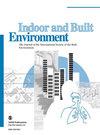PM2.5 bound polycyclic aromatic hydrocarbons in an Indian residential indoor air environment and their health risk
IF 2.9
3区 工程技术
Q2 CONSTRUCTION & BUILDING TECHNOLOGY
引用次数: 0
Abstract
Polycyclic Aromatic Hydrocarbons (PAHs), a group of semi-volatile organic pollutants with 2–7 aromatic rings are emitted in association with particulates/gases from incomplete combustion. They are persistent and affect human health adversely. This is the first study wherein PM2.5 bound PAHs from 8 different indoor air pollution sources, namely dhoop (DH1, DH2), incense sticks (IS1, IS2), cigarette, mosquito coil and solid fuels ‘coal and wood’, that are widely used in South-Asian countries were studied. Their emission rates and concentration profiles were compared. Dhoop was studied for the first time and found to be emitting the highest quantity of total PAHs. FLA/(FLA + PYR) ratio rightly indicated ingredients like wood and grass as sources. However, other ratios indicated petrogenic/coal origin, while BaP/(BaP + CHR) and BaA/(BaA + CHR) ratios were not reported earlier. The highest Toxicity Equivalent Concentration and Mutagenic Equivalent Concentration were estimated for DH2 and the lowest for cigarette smoke. The maximum Inhalation Lifetime Cancer Risk equal to 1.85 × 10−05 (adults) was observed for DH2, exceeding the WHO guidelines. These inferences will help in optimizing the indoor sources’ combustion duration and formulating manmade indoor sources. They will assist in identifying high-risk indoor environments, causative sources and control mechanisms.印度住宅室内空气环境中与 PM2.5 结合的多环芳烃及其健康风险
多环芳烃(PAHs)是一组具有 2-7 个芳香环的半挥发性有机污染物,与不完全燃烧产生的微粒/气体一起排放。多环芳烃具有持久性,对人体健康有不利影响。本研究首次对南亚国家广泛使用的 8 种不同室内空气污染来源(即熏香(DH1、DH2)、香棒(IS1、IS2)、香烟、蚊香和固体燃料 "煤和木材")中的 PM2.5 多环芳烃进行了研究。对它们的排放率和浓度曲线进行了比较。首次对 Dhoop 进行了研究,发现其排放的多环芳烃总量最高。FLA/(FLA + PYR) 比率正确地表明,木材和草等成分是多环芳烃的来源。然而,其他比率则表明来源于石油/煤炭,而 BaP/(BaP + CHR) 和 BaA/(BaA + CHR) 比率则是以前从未报道过的。据估计,DH2 的毒性当量浓度和突变当量浓度最高,香烟烟雾的毒性当量浓度和突变当量浓度最低。DH2 的最大吸入终生致癌风险为 1.85 × 10-05(成人),超过了世界卫生组织的指导方针。这些推论将有助于优化室内污染源的燃烧时间和制定人造室内污染源。它们将有助于确定高风险室内环境、致病源和控制机制。
本文章由计算机程序翻译,如有差异,请以英文原文为准。
求助全文
约1分钟内获得全文
求助全文
来源期刊

Indoor and Built Environment
环境科学-工程:环境
CiteScore
6.40
自引率
25.00%
发文量
130
审稿时长
2.6 months
期刊介绍:
Indoor and Built Environment publishes reports on any topic pertaining to the quality of the indoor and built environment, and how these might effect the health, performance, efficiency and comfort of persons living or working there. Topics range from urban infrastructure, design of buildings, and materials used to laboratory studies including building airflow simulations and health effects. This journal is a member of the Committee on Publication Ethics (COPE).
 求助内容:
求助内容: 应助结果提醒方式:
应助结果提醒方式:


